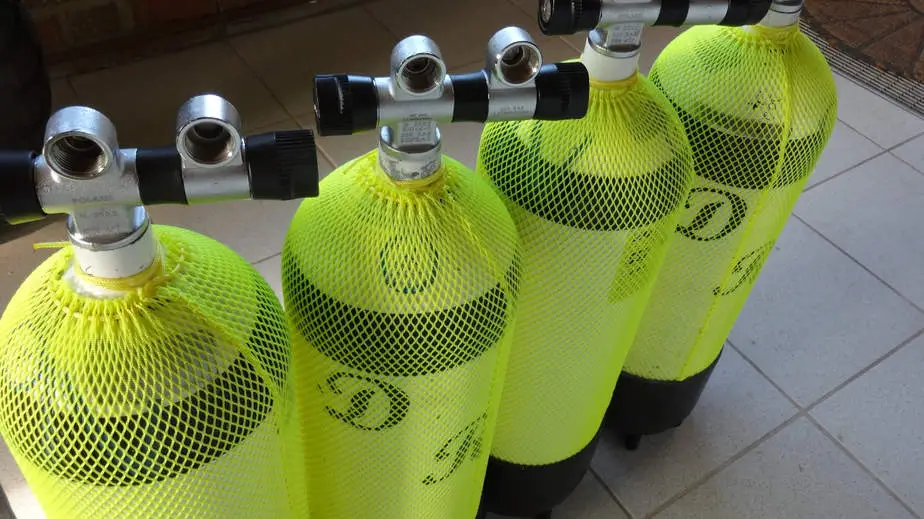Since you need to be certified in order to be a scuba diver, many people are wondering if a license is required in order to avail the services of a dive shop. For instance, can they purchase scuba gear? Can they get air refills for their scuba cylinder? Or do they need a license in order to do so?
If all you want is to get a simple air refill or purchase scuba equipment, then NO, you do not need a license. You do need a license if you want to fill or purchase a tank with a gas mix other than compressed air. This is because the customer must inspect the tank and confirm that the mix is correct. Additionally, if you want to fill your own tanks, then you need special equipment and specific training to safely do it.
How come standard air doesn’t require a license? Divers aren’t the only people who would want an air refill. Commonly, paintballers use a scuba cylinder to transfill the air to their paintball air tank. Or, a spouse may want to help their significant other fill their tank(s) even though they themselves aren’t certified. There are legitimate reasons why one would not have a license yet still want to fill a tank. However, for anything other than air, it’s best to get your cert card and let the professionals handle the refilling process.
Will dive shops ask for my license for a scuba tank refill?
Responsible dive shops will want to see your certification card before they fill your tank if you’re asking for anything other than air. With that said, the actual laws may differ from state to state and country to country. Don’t be surprised if you’re asked to present a license or to sign a liability release at the shop.
For those filling a scuba tank for non-scuba purposes, you won’t be asked for your license, however you’ll sign a release stating that you will not be using it for scuba diving. For similar reasons, dive shops will sell you scuba equipment even if you don’t have a license because you could be buying it for a friend or family member (who is certified) as a birthday gift or something.
With this information in mind, theoretically one could purchase a full set of scuba gear and get air refills all without being certified. They could also dive without a license; there are no scuba police to stop you. Even though it’s not illegal, if you don’t have a license or the requisite scuba training, then please, do NOT scuba dive. You will not only put your life in danger, but potentially others’ as well.
Additional requirements for a tank refill
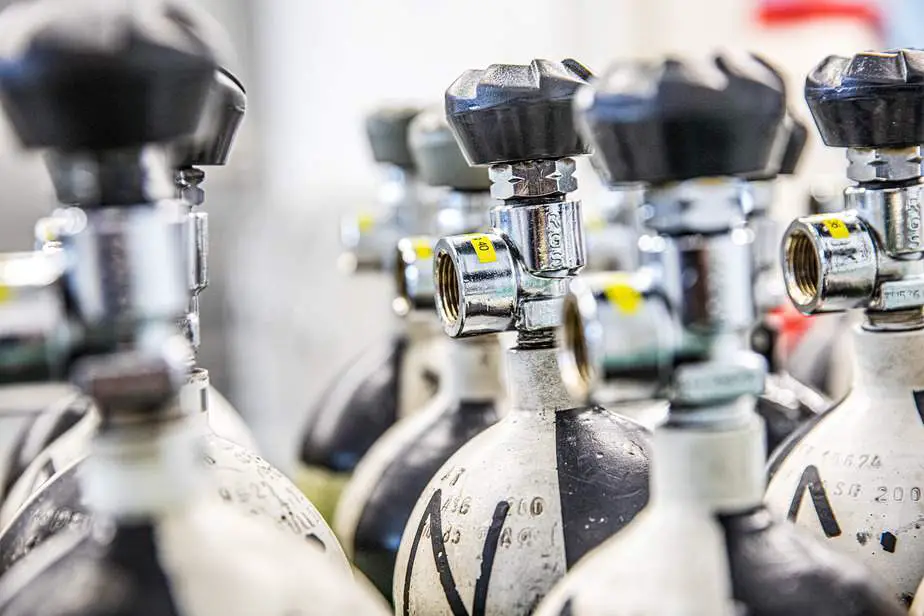
Other than checking for one’s certification, there are some mandatory tests that must be done on the tank itself to ensure it is safe to be filled.
All high-pressure tanks, not just scuba tanks, must pass two inspections to ensure that their integrity is not compromised. You wouldn’t want a high pressure tank to explode, for instance, so these tests are done for the safety of everyone involved.
The first test is a visual inspection that must be done for both the inside and outside of the tank. To inspect the inside of the tank, a snake camera is threaded in through the small opening. With the camera, the technician can use various imaging modes to verify the integrity of the tank. Specifically, the technician is looking for signs of internal corrosion or signs of distress in the material.
If a tank passes the visual inspection test, it will receive a sticker with the date of the inspection and the expiration date (one year later) printed on it. When you purchase or rent a tank, you want one with a sticker that is issued within the last 6 months which is considered recent. Dive shops will check that the tank has not passed the expiration date before issuing a refill.
The second test is the safety inspection where the technician will conduct a hydrostatic pressure test. Essentially, the tank is subjected to immense pressure using specialized equipment. The tank is over-pressurized to 167% of its rated capacity. To protect the technicians, the tank is placed in an armored tank and submerged in water before it is tested.
If a tank passes the hydrostatic test, then it will receive a stamp on the outside with the date of the inspection and expiration date printed on it. Hydro tests must be done once every 5 years. If you’re buying a tank, make sure that it’s been less than 2 years since the last hydro test in order for it to be considered “recent.”
Steel tanks have been known to pass several hydro tests, meaning they’ll last for decades if you take good care of them. Aluminum tanks are also designed to withstand immense stress. Dive shops will check that the expiration date has not passed. They themselves will do a general inspection before filling it.
Tanks that have been completely drained may be refused, and you may be asked to get the tank visually inspected again even if the current sticker is valid. The reason for this is that moisture can get inside an empty tank, causing internal corrosion and damage. You should maintain at least 20 bar / 300 psi in the tank to reduce the likelihood of this happening.
Where can you fill your scuba cylinder?
If you happen to own a scuba air compressor and have the sufficient knowledge to use it safely, then you can fill your own tanks with air. If you don’t have a compressor or want a gas mix other than air, then you need to visit a local dive shop that provides air refills. Don’t just go to the nearest one; we recommend shopping around first.
Nowadays, it’s really simple to look up reviews of dive shops online. Obviously you want to go to the one with good reviews. With that said, you can also shop around if you’re not satisfied with the prices they are charging you for a refill. The most important consideration in our opinion is that a dive shop has impeccable standards, even if they charge a bit more.
The staff at a dive shop must be qualified and professional. The air filters on their compressors must be replaced before it produces air that has contaminants in it. Even tiny amounts of contaminants can reach toxic levels under extreme compression.
If you ask a dive shop to show you their certifications and equipment test certificates for their air compressors, any dive shop worth their salt should have them and be willing to show you. If you like the standards at a dive shop are not up to safe levels, then it’s probably smart for you to go to another one.
Is it expensive to refill a scuba tank?
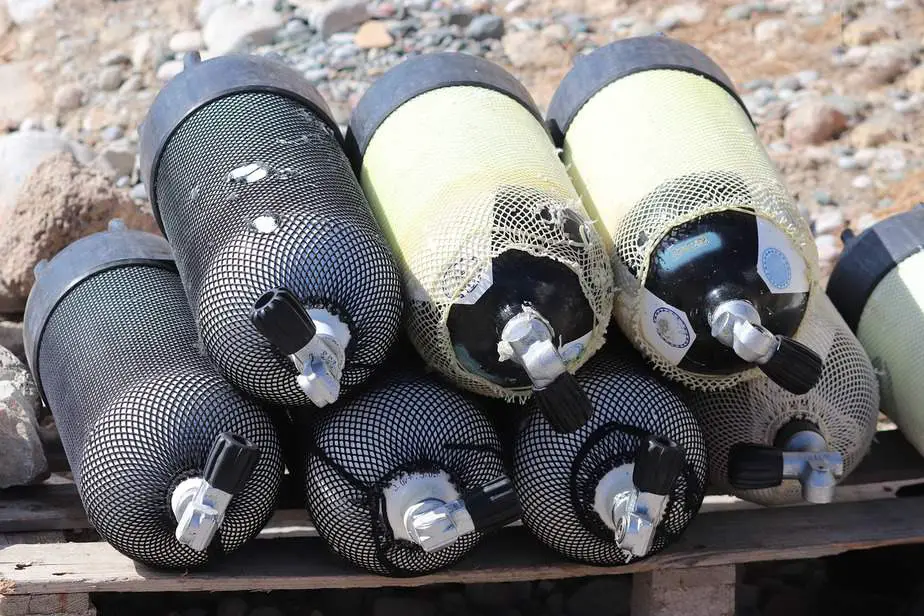
As we mentioned, the cost of refilling a scuba tank varies depending on location, size of tank, and what kind of gas mix you want to fill the tank with. Compressed air is generally cheap and should cost around $5 to $10. Have a look at the table below for a ballpark on price ranges.
| Gas Type | Capacity | Price |
| Compressed Air | Any capacity up to 207 bar | $5 |
| O2 Clean Air* | For cleaning or any capacity | $10 |
| Nitrox | 0-40 cu ft | $3 to $9 |
| Nitrox | Up to 80 cu ft | $5 to $20 |
| Nitrox | Up to 100 cu ft | $7 to $27 |
| Nitrox | Up to 120 cu ft | $10 to $32 |
| Helium | 1 cu ft | $3 |
| Oxygen | 1 cu ft | $0.40 |
Customers without a license can only fill their tanks with compressed air. If they wish to fill it with enriched air nitrox or helium for trimix, then they will need to present their certification card. Even if a customer is trying to fill a tank on someone else’s behalf (who is certified), unless prior arrangements were made, the staff will ask the diver who holds the certification to make the transaction in person.
If the price is a bit high for you, you need to consider whether the dive shop is reputable. Just because a shop has lower prices doesn’t mean their standards are up to par. Remember, you’re going to be breathing this stuff, so unless you’re okay with contaminants in your tank (you shouldn’t), it’s best for you to stick with a reputable shop whether the price is on the higher end or not. Don’t try to cut corners to save a few bucks when it can affect your health.
In a similar vein, some people want to buy their own air compressor so they can fill their own tanks. Yes, you can do this, but you must buy one specifically designed for scuba diving that produces air that is safe for breathing (more on that in the next section).
On top of that, you are responsible for maintaining it and replacing the filters. To do this properly, you’d need some training on air compressor maintenance and operation to prevent fatal accidents.
So, if you want to fill your own scuba tanks, it’s not as simple as buying a compressor and calling it a day. You really need to invest time and effort into it and learn the craft. Your life depends on it!
The risks of filling your own tank with an air compressor
If you have a standard air compressor, do NOT use it to fill your scuba tanks. You must specifically get a scuba air compressor. They come with a different design and most importantly, special filters that remove all contaminants from the air. To ensure air quality remains clean, filters must be regularly replaced before they let any through.
When you use a standard air compressor, such as one found in an auto shop, then plenty of contaminants can make it into the air. For instance, tiny droplets of oil used for lubricating the compressor, as well as traces of other pollutants, can be found in the air it puts out.
Standard compressors do have filters, however they are not fine enough to remove extremely fine contaminants like car exhaust fumes, which could end up in your tank. If you were filling up a tank so that you can transfill it to a paintball air tank, then it’s not that big of a deal. If you’re filling up a tank so that you can breathe from it, it can have deleterious effects on your health.
Aside from the health risks, there is also the risk of overfilling it. Overfilling a tank can degrade much faster than normal, and in very extreme cases, can explode as seen in the video above.
What are the other gas mixes? Why do I need to have a license to use them?
Recreational scuba divers can fill their tanks with two gases: compressed air or enriched air (nitrox). In order to avail nitrox, you must be a certified nitrox diver. Technical divers may order another type of gas mix called trimix which is nitrogen and oxygen combined with helium. Divers must be certified for trimix diving to order that.
If you want to fill your tank with nitrox or trimix, then the tank must be cleaned using special solutions to get rid of trace amounts of any flammable substances in the cylinder and valve before filling the tank with O2. This process is essential since pure oxygen is highly flammable. This cleaning service will be an extra charge on top of the cost of nitrox or trimix.
Since the risk of fire or explosion is high, naturally this means that only trained staff can handle this. On top of that, planning a dive with nitrox and trimix is different from compressed air, so the diver needs special training to be able to safely use them. Hence why dive shops ask you to present the relevant certification card and ask you to sign a liability log before they’ll perform these services for you.
Can air go stale in a scuba cylinder?
In general, you do not have to worry about the air going bad in a scuba tank if you are following proper procedures. If the air in the tank has been sufficiently filtered, then there should not be any contaminants in it that can cause the air quality to go bad even if it’s been left for a reasonable amount of time.
The reason why stale air is not a concern is because scuba tanks need to be emptied at least once a year for the visual inspection anyways. So there is actually a maximum time limit before the air is used up by, and one year is not long enough for properly filtered dry air to go bad.
Furthermore, part of your pre-dive check includes smelling the air from the tank that you’ll be using. Perhaps the air inside hadn’t been filtered properly and has gone bad. If you are ever in doubt about the air quality inside your tank, then don’t use it, empty the tank, and get it cleaned and refilled.
How do I know if my tanks have been filled properly?
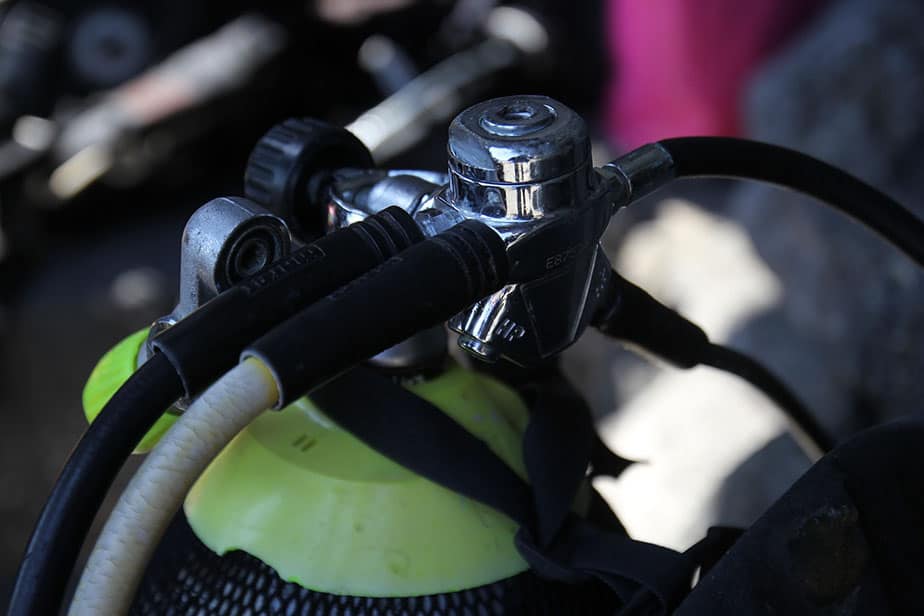
A reputable dive shop will keep their air compressors well-maintained by servicing it and regularly testing it to ensure that the air they’re supplying is safe enough to breathe. After all, if something goes wrong, they will be liable for the damages, so it’s in their best interest to do this.
Thus, when choosing which dive shop you want to fill your tank with, it’s reasonable for you to ask to see the test and service paperwork on their air compressor so you know that it’s up to date. If a dive shop refuses, then that should raise some alarms.
After they have filled your tank, you will want to verify that what’s inside the tank is exactly what you ordered. Dive shops should have tools for you, but you should bring your own trusty pressure gauge to see that it’s been filled. You don’t want to find out while you’re on the boat that your cylinder is not full.
For nitrox divers, you will need to verify that the oxygen content of the gas is what you expect. An enriched nitrox mix just means that the oxygen content is higher than compressed air, but there can be a range from 22% to 40%. The most common percentages are 32% and 36%. You need to know the exact percentage so you can set your dive computer correctly.
To verify the oxygen content, you will need to use an oxygen analyzer. The dive shop will let you borrow theirs, but you should have your own. After all, you’ll want to check again during your pre-dive check, and if you are a nitrox diver, then it will be very useful to not have to borrow it every time.
Similarly, technical divers who have ordered trimix gas will need to check the oxygen and helium content of their breathing gas.
When you order nitrox and trimix, you’ll need to sign a log confirming that the gas mix you received is what you ordered. You are only qualified to do this if you have the relevant certification card, however you do not need one for compressed air.
What are common sizes for scuba cylinders?
First, you need to consider that “size” for a scuba cylinder can mean two things. One is the actual physical size, and the second one is how much pressure a scuba tank has. Pressure in this case refers to how much breathing gas is crammed into the tank.
As you’d expect, a physically larger tank will also be able to store more breathing gas. However, there is also the consideration of the tank’s material. The two most popular tank materials are aluminum and steel. Aluminum is not as strong of a material as steel, and that has a few consequences.
With aluminum tanks, since the material is weaker, more aluminum is required to construct a tank of equal strength to a steel one. This means that the aluminum tank is necessarily thicker than the steel tank, meaning it also has less space inside to store the gas. That’s why you’ll often find that aluminum tanks tend to store less breathing gas compared to a steel tank of similar size.
The table below lists the approximate height measurements for the most popular types of tanks.
| Height | Tank |
| 20-21 Inches | AL63, HP80 |
| 24 Inches | HP100, HP117 |
| 26 Inches | AL80, AL100 |
| 28-30 Inches | HP120, HP133 |
While tank height is an important consideration, the more important size factor to consider is tank diameter. Most tanks have a diameter of 7¼ inches. Larger tanks will have a diameter of 8 inches. This shouldn’t be an issue for your BCD, but it can get annoying having to adjust your tank bands if you dive with cylinders that have different diameters.
A standard recreational scuba tank is filled to 3,000 psi / 200 bar / 80 cu ft and they are referred to as “AL80”. When comparing an aluminum tank to a steel tank, the aluminum tank will be larger and bulkier compared to the steel tank of equal pressure. With that said, the vast majority of scuba tanks that you’ll find at dive resorts are alu 80. They are popular because of their low cost compared to steel tanks.
In addition to size, there is also a consideration of a scuba tank’s weight. Since aluminum tanks need to be thicker in order to hold the same max pressure as a steel tank, aluminum tanks are actually heavier than steel tanks despite aluminum being the lighter material. However, when an aluminum tank is empty, it will float in water whereas a steel tank will not float whether it’s full or not.
Additional scuba tank info
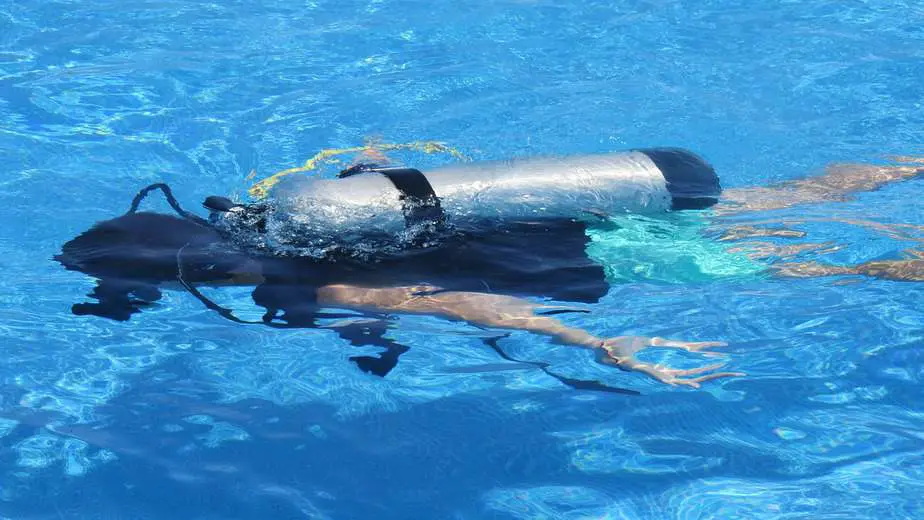
You can purchase larger and more expensive tanks capable of a higher working pressure. However, unless you’re doing technical diving, it’s unlikely you’ll need more than an alu 80 tank. Even if you don’t have a license, you need to figure out what your tank is rated to so you know how much to refill the tank at the dive shop.
Do not try to cram more air into the tank than what it’s rated for. The only time it’s okay is if a technician is doing a hydrostatic test with the proper equipment. Any other instance can drastically shorten your tank’s life and may even result in catastrophic failure.
Modern tanks are now designed with a burst disk inside the valve which will open and release the air inside in the event of extreme overfilling. The bust disk will rupture if the maximum working pressure is too high.
Keep in mind that the internal pressure of a tank can also be affected by temperature changes from when it was filled. As a general rule of thumb, the pressure will increase by 0.6 bar for each 1°C or 5 psi for each 1°F.
Make sure to store your tank in a cool and dry place. If you leave your tank in direct sunlight or in the trunk of your car, the pressure may rise to a point where it damages your equipment. Similarly, the tank pressure will decrease in colder temperatures, however that’s much safer than the reverse.
Another thing to keep in mind is that your scuba regulator also has a maximum working pressure depending on if it’s a DIN or Yoke regulator. For either one, it should be rated to work with pressures slightly higher than that of the tank. If your regulator is incompatible with your tank, there are adapters you can buy to make it easy to switch between the two types.
Parting words
In summary, you do not need a license to fill a scuba tank if you are only filling it with compressed air. You also do not need a license if you want to purchase a scuba tank or other scuba gear. A license is required for ordering nitrox and trimix.
No matter what gas mix you’re ordering, the dive shop will check that your tank has valid inspection stickers so that it’s safe to fill. If it has not been visually inspected within the past year, or hydrostatic tested within the last 5 years, they will not fill your tank whether you have a license or not.
It’s not recommended that you try to save a few bucks by filling your own tank unless you have a scuba compressor and the requisite training to use it. You should be going to reputable dive shops that have good reviews and aren’t afraid to show their test and service paperwork for their compressors.
Even if you own an air compressor, unless it is specifically a scuba compressor, then the air it provides will not be breathable. The air filter needs to be able to filter out all the contaminants; even a little bit can be a health hazard when you breathe it in while compressed.
Furthermore, even if you don’t have a license, you should still know some basic information about your scuba tank. For instance, you need to know how much pressure it can handle so that it doesn’t get overfilled. You should also have a pressure gauge to know when it is filled and when it needs to get refilled.
It’s better to have peace of mind and let a reputable dive shop worry about air compressor maintenance and filling the tank properly. If you’re only filling compressed air then it’s not even expensive, often around $5 to $10. That’s just a small price to pay to know that the air you’re breathing underwater is safe and clean.
If you’re interested in purchasing your own scuba tank instead of renting all of the time, then you should read our scuba tank buying guide before you make a purchase.

